Critical Thinking and Reflection on Alcohol Advertising Effects
VerifiedAdded on 2021/11/05
|6
|995
|41
Homework Assignment
AI Summary
This assignment critically examines the relationship between alcohol advertising and underage drinking, drawing from a provided article that links media exposure to increased alcohol consumption among youth. The student answers several critical thinking and reflection questions, analyzing the influence of advertising, discussing whether it is a more significant factor than other influences, and proposing government interventions to regulate alcohol advertisements. The assignment also explores responsible advertising practices and suggests methods to communicate messages about alcohol use to the youth. The student discusses the pros and cons of alcohol advertising, including its potential to educate the public while acknowledging the risks of long-term effects like alcoholism and the impact on behaviors and criminal activities. References to supporting literature are included.
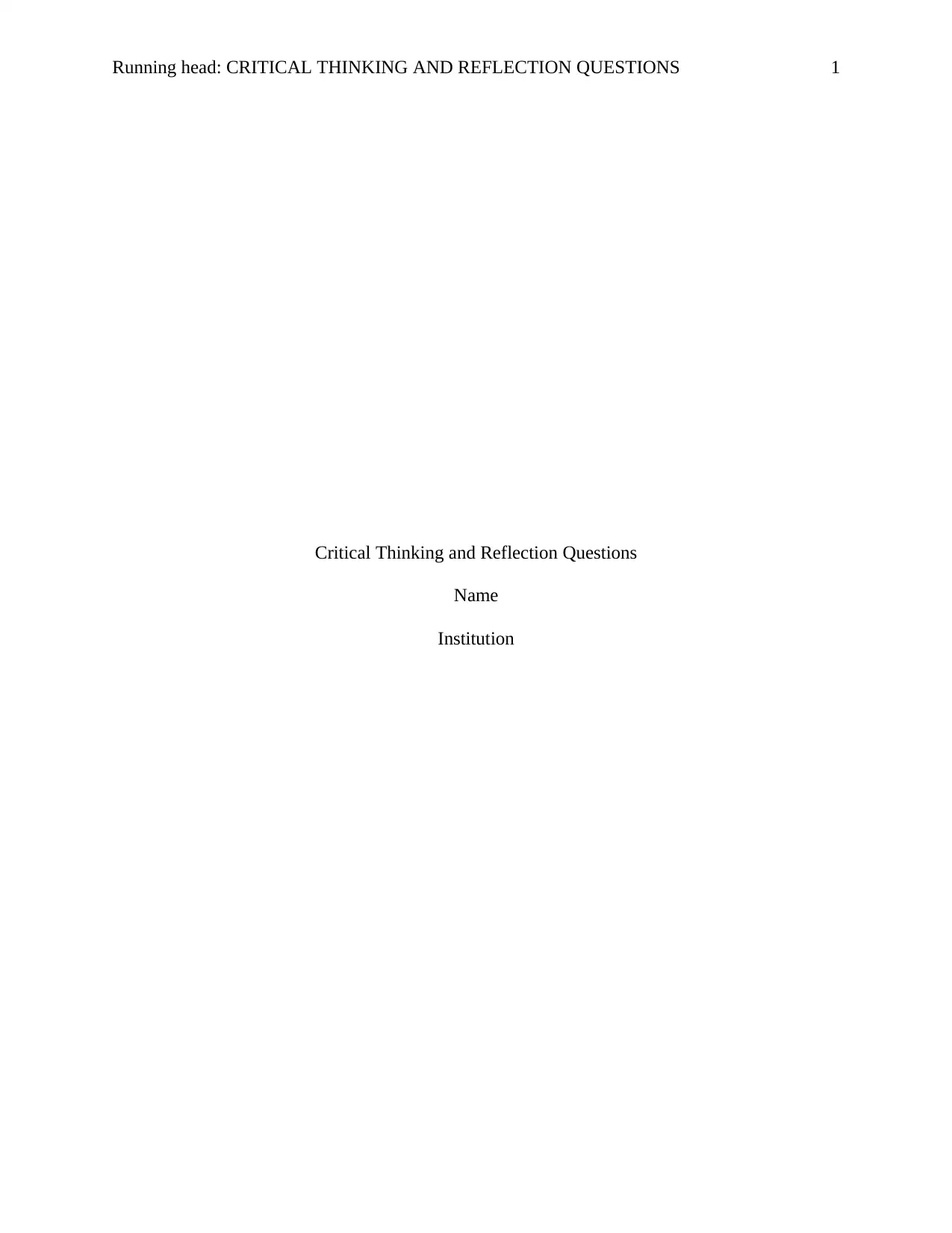
Running head: CRITICAL THINKING AND REFLECTION QUESTIONS 1
Critical Thinking and Reflection Questions
Name
Institution
Critical Thinking and Reflection Questions
Name
Institution
Paraphrase This Document
Need a fresh take? Get an instant paraphrase of this document with our AI Paraphraser
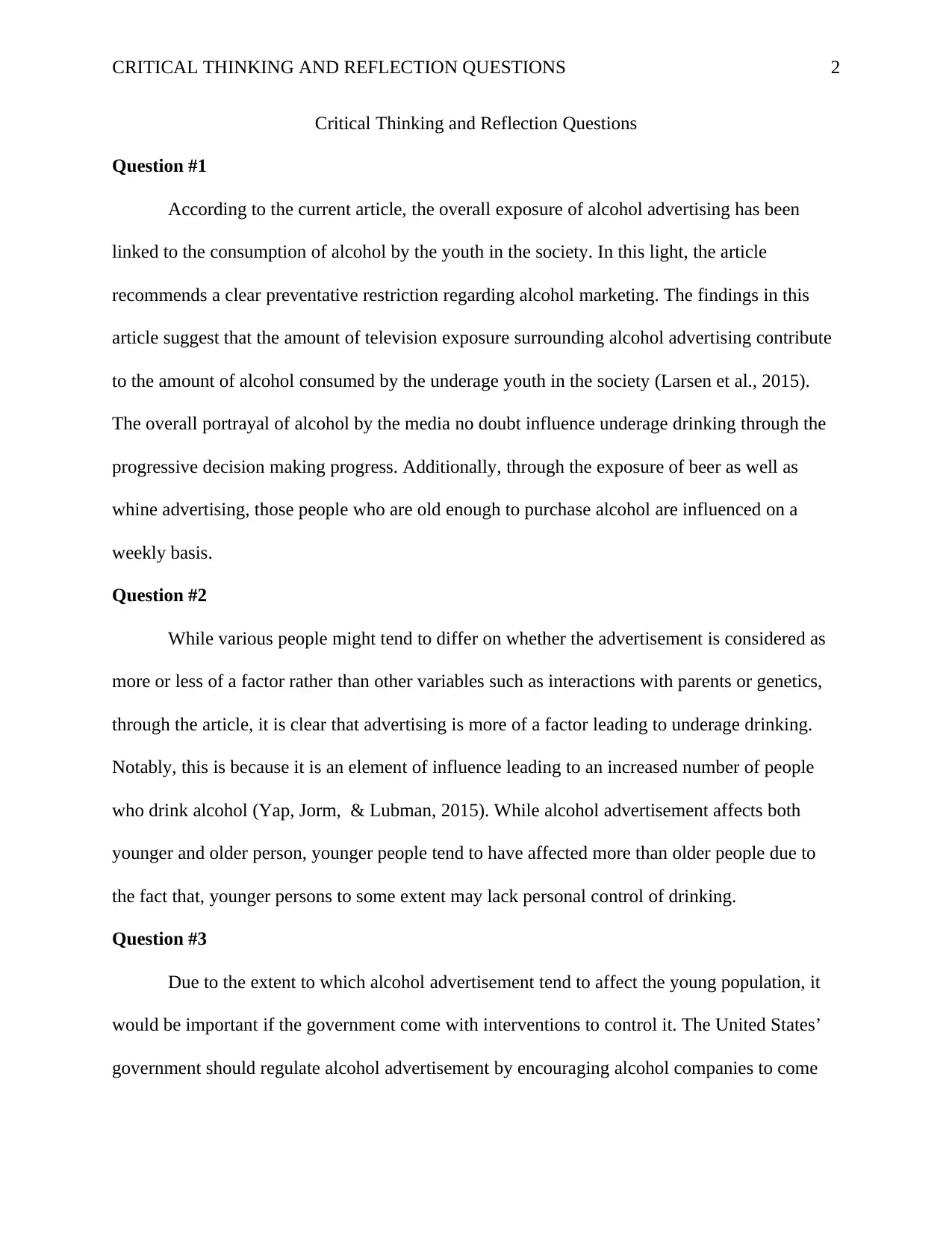
CRITICAL THINKING AND REFLECTION QUESTIONS 2
Critical Thinking and Reflection Questions
Question #1
According to the current article, the overall exposure of alcohol advertising has been
linked to the consumption of alcohol by the youth in the society. In this light, the article
recommends a clear preventative restriction regarding alcohol marketing. The findings in this
article suggest that the amount of television exposure surrounding alcohol advertising contribute
to the amount of alcohol consumed by the underage youth in the society (Larsen et al., 2015).
The overall portrayal of alcohol by the media no doubt influence underage drinking through the
progressive decision making progress. Additionally, through the exposure of beer as well as
whine advertising, those people who are old enough to purchase alcohol are influenced on a
weekly basis.
Question #2
While various people might tend to differ on whether the advertisement is considered as
more or less of a factor rather than other variables such as interactions with parents or genetics,
through the article, it is clear that advertising is more of a factor leading to underage drinking.
Notably, this is because it is an element of influence leading to an increased number of people
who drink alcohol (Yap, Jorm, & Lubman, 2015). While alcohol advertisement affects both
younger and older person, younger people tend to have affected more than older people due to
the fact that, younger persons to some extent may lack personal control of drinking.
Question #3
Due to the extent to which alcohol advertisement tend to affect the young population, it
would be important if the government come with interventions to control it. The United States’
government should regulate alcohol advertisement by encouraging alcohol companies to come
Critical Thinking and Reflection Questions
Question #1
According to the current article, the overall exposure of alcohol advertising has been
linked to the consumption of alcohol by the youth in the society. In this light, the article
recommends a clear preventative restriction regarding alcohol marketing. The findings in this
article suggest that the amount of television exposure surrounding alcohol advertising contribute
to the amount of alcohol consumed by the underage youth in the society (Larsen et al., 2015).
The overall portrayal of alcohol by the media no doubt influence underage drinking through the
progressive decision making progress. Additionally, through the exposure of beer as well as
whine advertising, those people who are old enough to purchase alcohol are influenced on a
weekly basis.
Question #2
While various people might tend to differ on whether the advertisement is considered as
more or less of a factor rather than other variables such as interactions with parents or genetics,
through the article, it is clear that advertising is more of a factor leading to underage drinking.
Notably, this is because it is an element of influence leading to an increased number of people
who drink alcohol (Yap, Jorm, & Lubman, 2015). While alcohol advertisement affects both
younger and older person, younger people tend to have affected more than older people due to
the fact that, younger persons to some extent may lack personal control of drinking.
Question #3
Due to the extent to which alcohol advertisement tend to affect the young population, it
would be important if the government come with interventions to control it. The United States’
government should regulate alcohol advertisement by encouraging alcohol companies to come
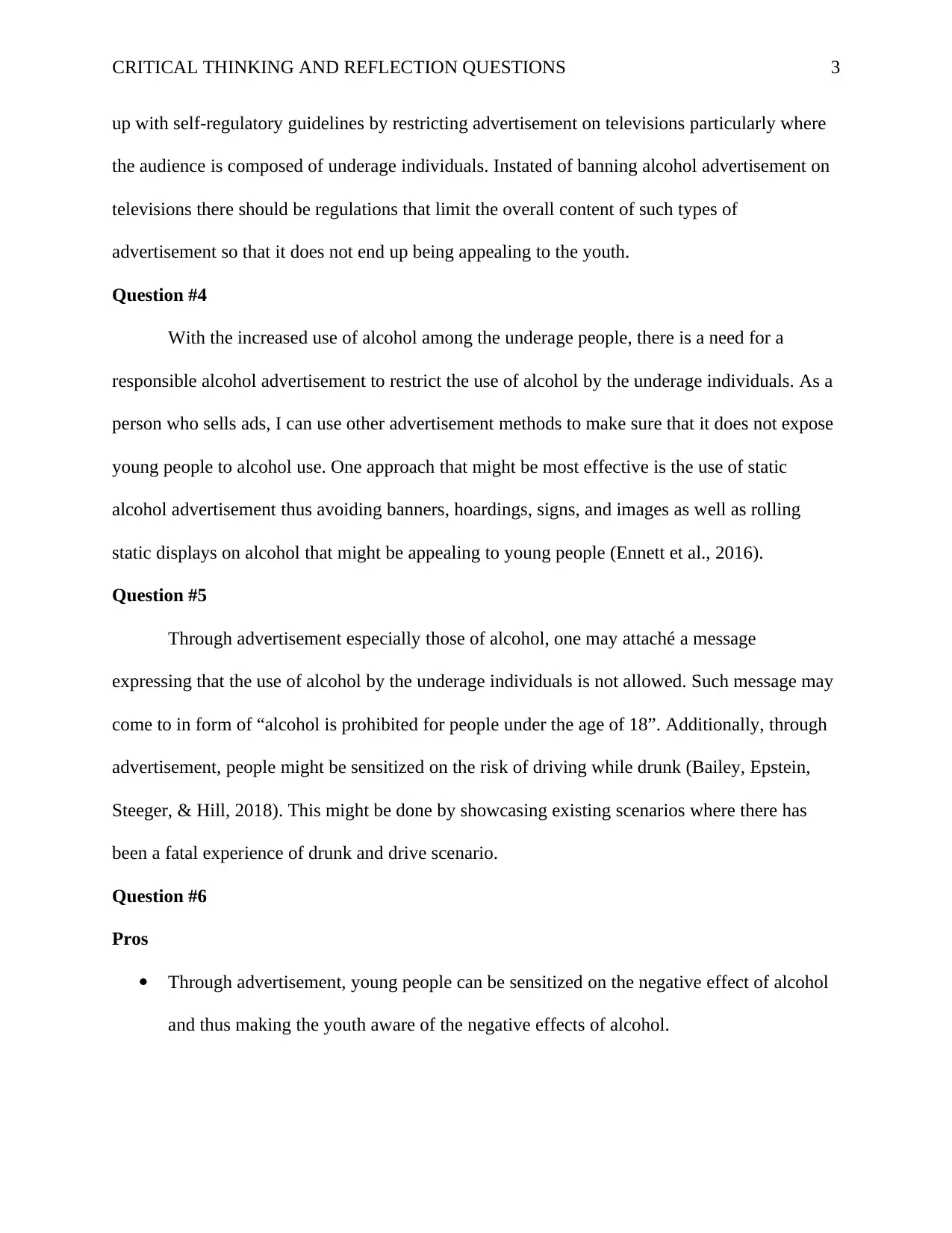
CRITICAL THINKING AND REFLECTION QUESTIONS 3
up with self-regulatory guidelines by restricting advertisement on televisions particularly where
the audience is composed of underage individuals. Instated of banning alcohol advertisement on
televisions there should be regulations that limit the overall content of such types of
advertisement so that it does not end up being appealing to the youth.
Question #4
With the increased use of alcohol among the underage people, there is a need for a
responsible alcohol advertisement to restrict the use of alcohol by the underage individuals. As a
person who sells ads, I can use other advertisement methods to make sure that it does not expose
young people to alcohol use. One approach that might be most effective is the use of static
alcohol advertisement thus avoiding banners, hoardings, signs, and images as well as rolling
static displays on alcohol that might be appealing to young people (Ennett et al., 2016).
Question #5
Through advertisement especially those of alcohol, one may attaché a message
expressing that the use of alcohol by the underage individuals is not allowed. Such message may
come to in form of “alcohol is prohibited for people under the age of 18”. Additionally, through
advertisement, people might be sensitized on the risk of driving while drunk (Bailey, Epstein,
Steeger, & Hill, 2018). This might be done by showcasing existing scenarios where there has
been a fatal experience of drunk and drive scenario.
Question #6
Pros
Through advertisement, young people can be sensitized on the negative effect of alcohol
and thus making the youth aware of the negative effects of alcohol.
up with self-regulatory guidelines by restricting advertisement on televisions particularly where
the audience is composed of underage individuals. Instated of banning alcohol advertisement on
televisions there should be regulations that limit the overall content of such types of
advertisement so that it does not end up being appealing to the youth.
Question #4
With the increased use of alcohol among the underage people, there is a need for a
responsible alcohol advertisement to restrict the use of alcohol by the underage individuals. As a
person who sells ads, I can use other advertisement methods to make sure that it does not expose
young people to alcohol use. One approach that might be most effective is the use of static
alcohol advertisement thus avoiding banners, hoardings, signs, and images as well as rolling
static displays on alcohol that might be appealing to young people (Ennett et al., 2016).
Question #5
Through advertisement especially those of alcohol, one may attaché a message
expressing that the use of alcohol by the underage individuals is not allowed. Such message may
come to in form of “alcohol is prohibited for people under the age of 18”. Additionally, through
advertisement, people might be sensitized on the risk of driving while drunk (Bailey, Epstein,
Steeger, & Hill, 2018). This might be done by showcasing existing scenarios where there has
been a fatal experience of drunk and drive scenario.
Question #6
Pros
Through advertisement, young people can be sensitized on the negative effect of alcohol
and thus making the youth aware of the negative effects of alcohol.
⊘ This is a preview!⊘
Do you want full access?
Subscribe today to unlock all pages.

Trusted by 1+ million students worldwide
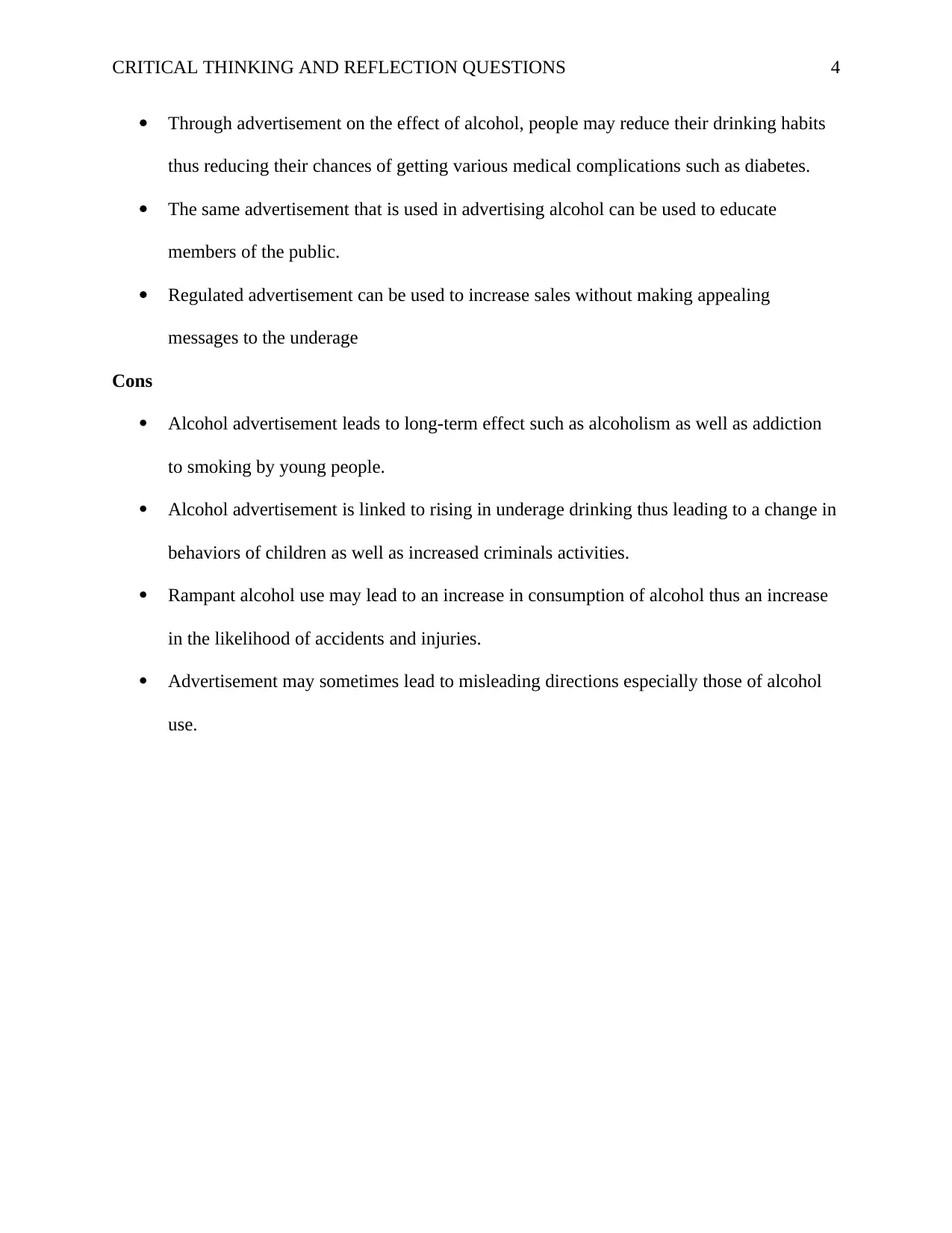
CRITICAL THINKING AND REFLECTION QUESTIONS 4
Through advertisement on the effect of alcohol, people may reduce their drinking habits
thus reducing their chances of getting various medical complications such as diabetes.
The same advertisement that is used in advertising alcohol can be used to educate
members of the public.
Regulated advertisement can be used to increase sales without making appealing
messages to the underage
Cons
Alcohol advertisement leads to long-term effect such as alcoholism as well as addiction
to smoking by young people.
Alcohol advertisement is linked to rising in underage drinking thus leading to a change in
behaviors of children as well as increased criminals activities.
Rampant alcohol use may lead to an increase in consumption of alcohol thus an increase
in the likelihood of accidents and injuries.
Advertisement may sometimes lead to misleading directions especially those of alcohol
use.
Through advertisement on the effect of alcohol, people may reduce their drinking habits
thus reducing their chances of getting various medical complications such as diabetes.
The same advertisement that is used in advertising alcohol can be used to educate
members of the public.
Regulated advertisement can be used to increase sales without making appealing
messages to the underage
Cons
Alcohol advertisement leads to long-term effect such as alcoholism as well as addiction
to smoking by young people.
Alcohol advertisement is linked to rising in underage drinking thus leading to a change in
behaviors of children as well as increased criminals activities.
Rampant alcohol use may lead to an increase in consumption of alcohol thus an increase
in the likelihood of accidents and injuries.
Advertisement may sometimes lead to misleading directions especially those of alcohol
use.
Paraphrase This Document
Need a fresh take? Get an instant paraphrase of this document with our AI Paraphraser
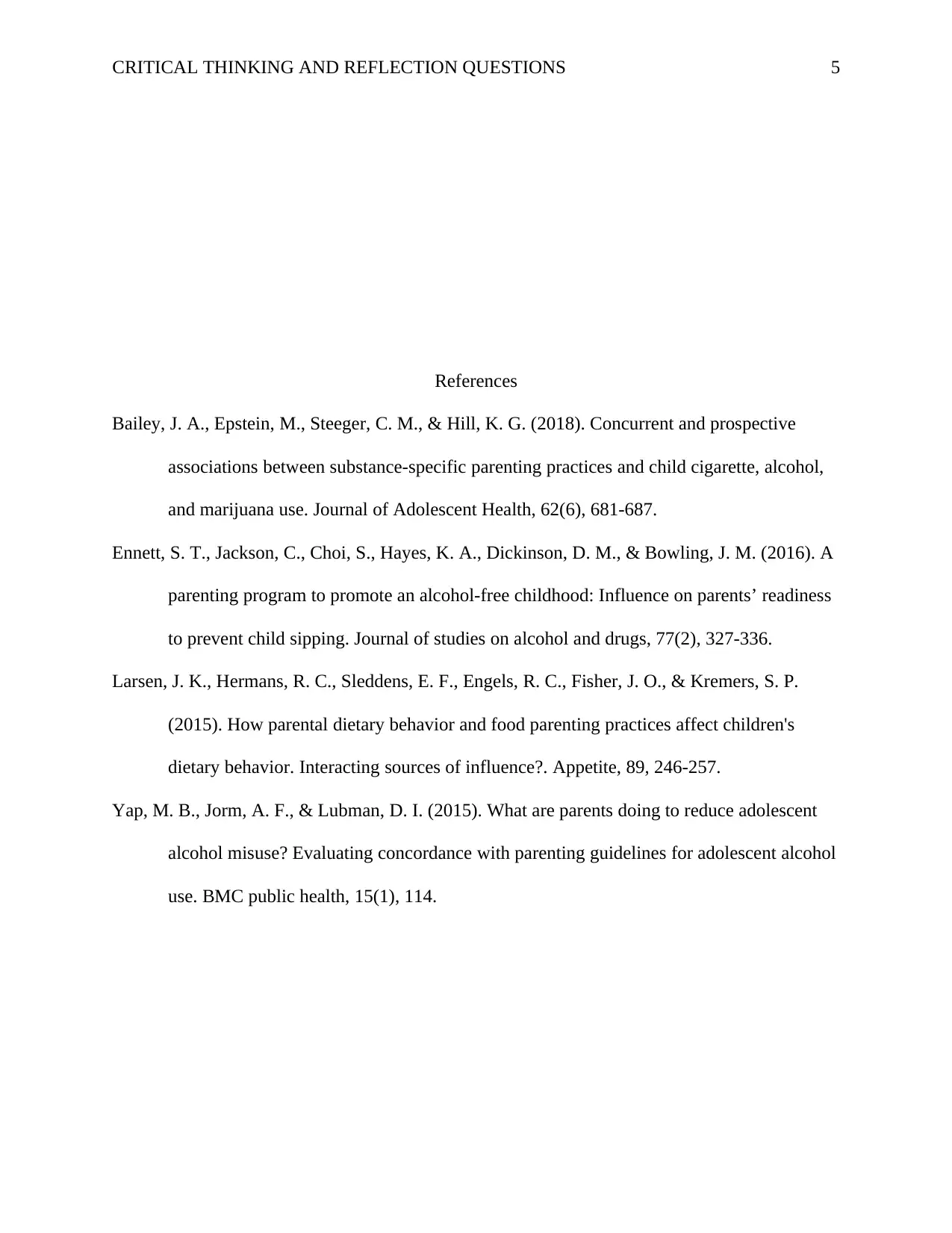
CRITICAL THINKING AND REFLECTION QUESTIONS 5
References
Bailey, J. A., Epstein, M., Steeger, C. M., & Hill, K. G. (2018). Concurrent and prospective
associations between substance-specific parenting practices and child cigarette, alcohol,
and marijuana use. Journal of Adolescent Health, 62(6), 681-687.
Ennett, S. T., Jackson, C., Choi, S., Hayes, K. A., Dickinson, D. M., & Bowling, J. M. (2016). A
parenting program to promote an alcohol-free childhood: Influence on parents’ readiness
to prevent child sipping. Journal of studies on alcohol and drugs, 77(2), 327-336.
Larsen, J. K., Hermans, R. C., Sleddens, E. F., Engels, R. C., Fisher, J. O., & Kremers, S. P.
(2015). How parental dietary behavior and food parenting practices affect children's
dietary behavior. Interacting sources of influence?. Appetite, 89, 246-257.
Yap, M. B., Jorm, A. F., & Lubman, D. I. (2015). What are parents doing to reduce adolescent
alcohol misuse? Evaluating concordance with parenting guidelines for adolescent alcohol
use. BMC public health, 15(1), 114.
References
Bailey, J. A., Epstein, M., Steeger, C. M., & Hill, K. G. (2018). Concurrent and prospective
associations between substance-specific parenting practices and child cigarette, alcohol,
and marijuana use. Journal of Adolescent Health, 62(6), 681-687.
Ennett, S. T., Jackson, C., Choi, S., Hayes, K. A., Dickinson, D. M., & Bowling, J. M. (2016). A
parenting program to promote an alcohol-free childhood: Influence on parents’ readiness
to prevent child sipping. Journal of studies on alcohol and drugs, 77(2), 327-336.
Larsen, J. K., Hermans, R. C., Sleddens, E. F., Engels, R. C., Fisher, J. O., & Kremers, S. P.
(2015). How parental dietary behavior and food parenting practices affect children's
dietary behavior. Interacting sources of influence?. Appetite, 89, 246-257.
Yap, M. B., Jorm, A. F., & Lubman, D. I. (2015). What are parents doing to reduce adolescent
alcohol misuse? Evaluating concordance with parenting guidelines for adolescent alcohol
use. BMC public health, 15(1), 114.
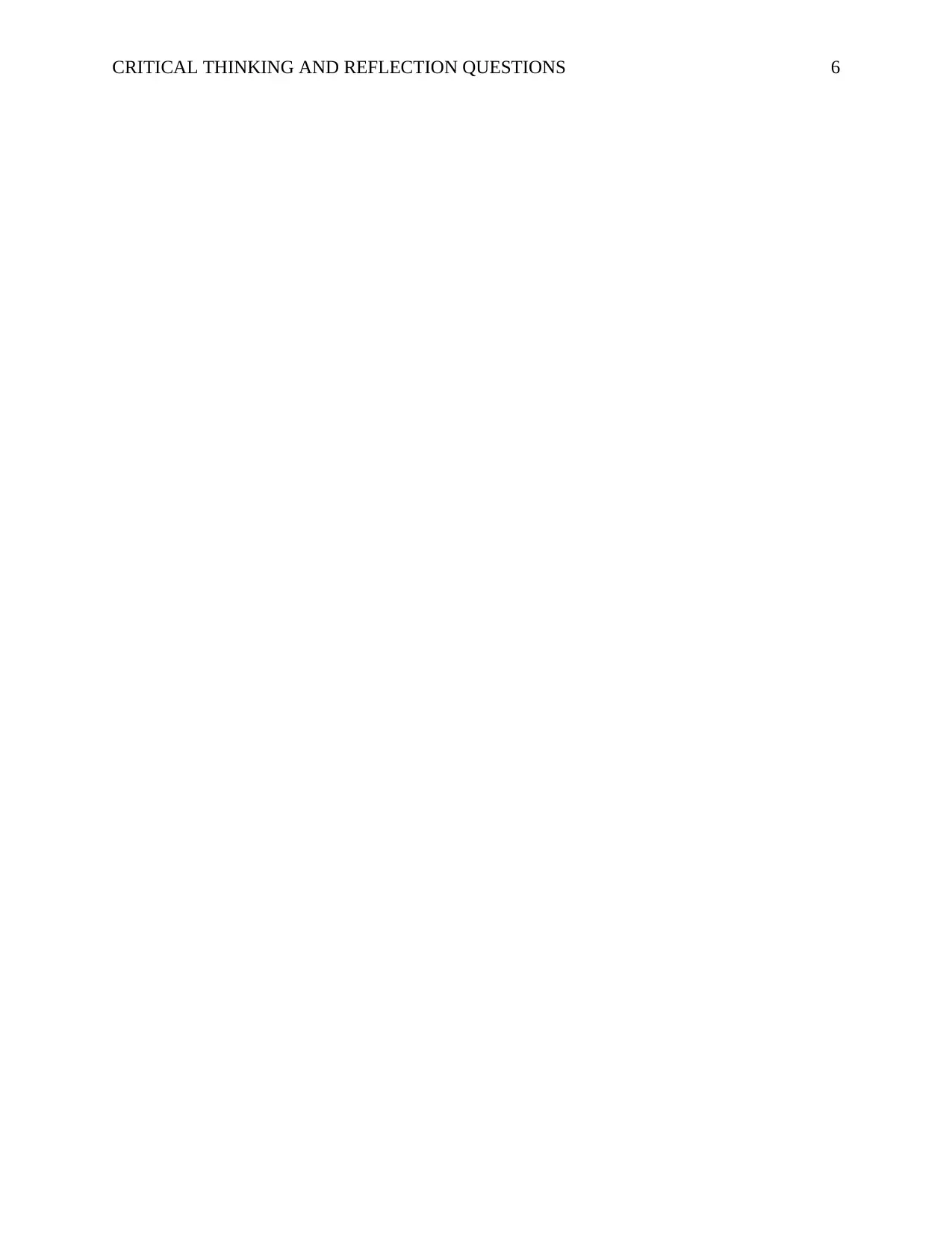
CRITICAL THINKING AND REFLECTION QUESTIONS 6
⊘ This is a preview!⊘
Do you want full access?
Subscribe today to unlock all pages.

Trusted by 1+ million students worldwide
1 out of 6
Your All-in-One AI-Powered Toolkit for Academic Success.
+13062052269
info@desklib.com
Available 24*7 on WhatsApp / Email
![[object Object]](/_next/static/media/star-bottom.7253800d.svg)
Unlock your academic potential
Copyright © 2020–2025 A2Z Services. All Rights Reserved. Developed and managed by ZUCOL.
